Yesterday I talked about the world building I have explaining the basic foundation of elves in the setting, and in the process, described a set of different ‘elves’ that players have access to for building their own characters. But that was more a sort of top-down cladistic vision of them. What are those elves like, what does it mean to be a member of those elven cultures? How do they view one another and what kind of characters do they allow?
Glossary Note: Conventionally, the term used in D&D for this mechanical package is race. This is the typical term, and in most conversations about this game system, the term you’re going to wind up using is race. For backwards compatibility and searchability, I am including this passage here. The term I use for this player option is heritage.
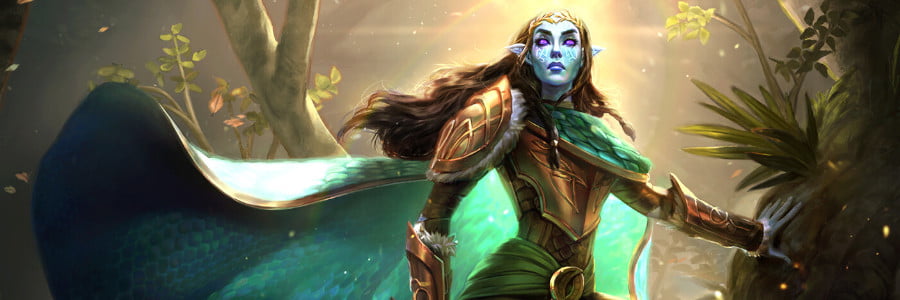
First Elves
These are not a player option! They’re also literally mythic – but there are two distinct threads of how these myths are regarded.
- Elves think of the First Elves as myth and may even see them as ‘faerie kings’ that weren’t related to Elves at all. Some even tell stories of escaping the First Elves.
- Eladrin think of the First Elves as ‘better Eladrin’, and assume all the stories of cruelty are exaggerated perspectives of people who feared their perfection.
This is to say, Elves consider their earlier identity something they had to escape, and the Eladrin consider their earlier identity something misunderstood as it reflects on them.
Elves
First up, your classic foundational elf. The kind of thing people are going to get when they angle at a Legolas-type, a green woodland type of character. Visually, these Elves are pretty much your standard humanoid with pointy ears, but they also have horns, which can take a variety of forms based on what’s cool. This is because I think they’re neat, based on the Lorwyn and Dragon Prince elves.
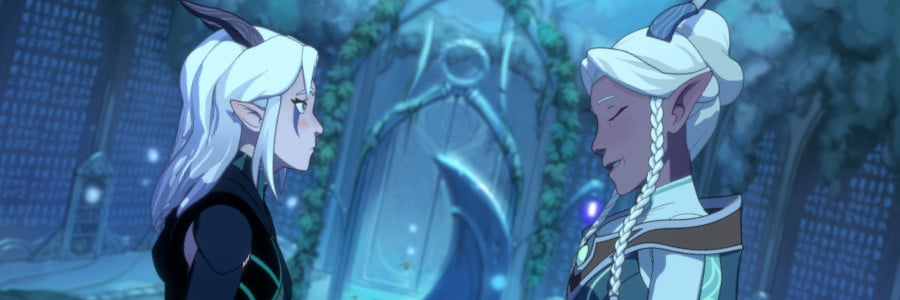
Elves live in the forests, in settlements they build that integrate into the forest. They hunt and farm, but their farming is supplemented by a culture of magical improvement of the land – so they don’t have farms that look like farms, just trees and groves that are fantastically bounteous. This does mean they don’t tend to have lots of grains but they do have lots of fruits and some of what we consider vegetables – like, eggplants and pumpkins and peppers. This ‘elf’ is the thing that’s seen as the orcs’ counterpart – they tend to exist in similar areas and compete for similar resources, with elves typically being more likely to use traps and pursuing things from a distance through bows, while orcs are more likely to hunt through endurance in groups.
These are the ‘made of meat’ elves. You probably know someone in your community who knows and does magic, but you don’t assume any Elf would know or do something with magic. People in your community make specialised tools, and you probably partake in (literal, actual) rituals that do things for your community like grow new trees for homes.
Elves also are the ones whose ‘elven’ language is the most coherent and understandable. If a non-elf knows ‘Elven’ they probably learned this variant.
Eladrin
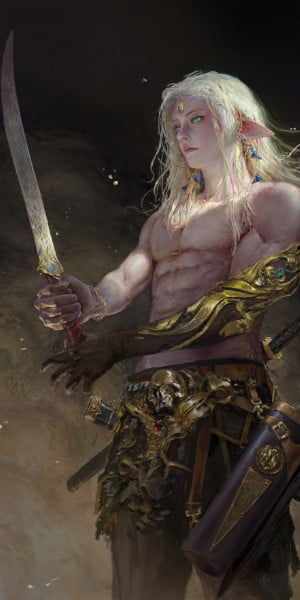
Eladrin live in the Eladrin Kingdoms, a number of cities and lodges around the world that are regarded as extremely well-hidden, or obscured by nature and forest. It is rarely known in-setting, but these places are actually in extra-dimensional spaces; you may walk down a road and see a castle appear up ahead you didn’t notice twenty steps back, because the road leads through an Eladrin Pathway (a type of Fey Portal). These are your classic, towering, impossible buildings, with too-narrow supports and too-thin crystalline structures holding up towers that can’t even hold in a breeze. These places are renowned for excellent weather, and even have some strange properties that people outside don’t realise it — Eladrin wine literally ferments differently within Eladrin spaces.
This is reflected in how they make food and handle infrastructure – it’s often either literally magical, or only handled in a way they find aesthetically pleasant. An acqueduct isn’t worth building if everyone teleports water into their house, but if it looks very nice, they might go for it. Eladrin do poop, but their toilets just make the poo disappear, rather than teleporting it out of their body like a bunch of weirdoes.
These are the ‘magical fey’ Elves. The Eladrin exist in a society that is mostly a magocracy, is extremely static, and tends to view adventuring as a hobby. Not the adventurer – but if an Eladrin hears another Eladrin is travelling out there doing adventures, they’d regard it like they learned they were a stamp collector or into learning languages. Another detail about Eladrin is that they live a long time but also are a little wobbly when it comes to time; it’s sometimes referred to as ‘thick’ and ‘thin’ years – time spent on their own in their own society in the bubble of their research passes easily, and quickly. But when they interact with people outside, they don’t realise that they are just doing more stuff in the same amount of time — operating at the speed and with the time of their peers who have to relate to the world properly.
Half-Elves
Eladrin don’t really think of the Half-Elves as a thing. Oh they acknowledge they exist, but the fact that there are half-elf communities on the periphery of Elven communities and near the human communities, that’s seen as a kind of rounding error.
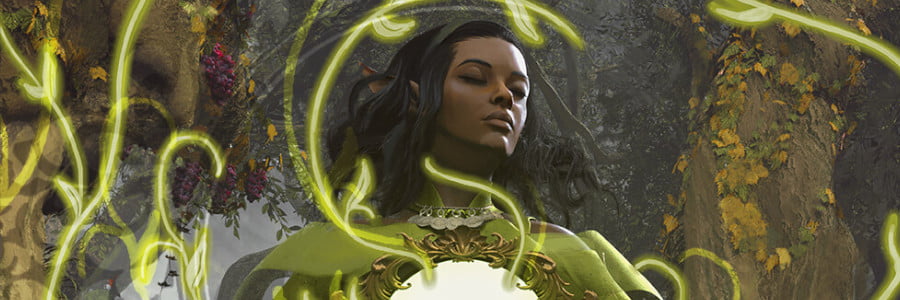
As it is, half-elves work in Cobrin’Seil on a very case-by-case basis. There are communities where ‘everyone’s a half-elf’ because enough people in the past were half-elves and humans and elves do move into the area because they’re nearby, but there are also plenty of lone half-elves who are the byproduct of a couple that found each other out of context.
Half-elves may or may not have antlers, they may or may not have pointy ears, and honestly, they may be the origin of the term ‘cuckold’ in the Cobrin’Seil universe, a term that still strikes me as funny and dumb because the term itself is trying to make it a bad thing to have totally sick antlers and you don’t even need to do anything with them.
Drow
The drow are a group of elves who separated out from the Elves, off on their own. While the historical purpose of ‘drow’ in D&D is typically an othered culture of ‘what if the culture we know but evil-bad’ and signifies them with imagery like spiders and slimes (okay) and matriarchy (uh?) and black skin (hang on), the drow in Cobrin’Seil are a political entity first and foremost. And there needs to be a good and big reason for them to be a separate entity to the elves and still have an aesthetic that players can look at and go ‘oh okay that’s a drow.’

Particularly, the Drow of Cobrin’Seil are Elves that think the Eladrin have got it right. Rather than dozens of small communities spread across territory with their own little lords and elders and no standard centralised government, the Drow think that the Eladrin creation of gateways to protect themselves and these little pocket places represent the safest ideal and they know that as a relative culture, the Eladrin shouldn’t be able to do something the Drow can’t do themselves.
Rather than representing ‘black people,’ the Drow of Cobrin’Seil are isolationists. They separated from the elves because their ideology is to keep themselves isolated. Elven communities are pretty isolated, but they’re not isolationist (unless that one community’s local authorities think they should be). There’s a lot of variety amongst the elves, in part because they don’t have a centralised authority. The Drow political position is that those two things are bad; that it’s better to have a single central authority, and in so doing, get rid of variety in you political structures. The Elven position is a bit ‘we live so long, most things will sort out over time, so we don’t need to worry about what faster cultures are doing that much, they’ll get over it,’ while the Drow position is ‘we live so long, we can’t afford anything that presents threats to our longevity, because lost lives are losing so much more time.’
This separation led to the Drow adorning themselves with an aesthetic that says ‘go away’ in animal terms; broken, dark roots, thorns, barbs, animal skulls and bones, and colours meant to blend in to dark spaces, like dark purples and blues.
The Drow have a set of city-states connected by a web of portals, but they’re like the Eladrin homes – the ‘underdark’ is a set of access ways to these cities in pocket universes, but the aesthetic of these pockets is of underground caverns, interconnected and cursed.
As part of the separation, Drow took up a practice of patterning their bodies, decorating themselves with magical body art. This art is almost like a sort of checksum – each child has art that, when compared to their parents’ art, be used as ‘proof of parentage.’ This is seen as a completely reliable proof of heritage and fidelity and completely unable to make mistakes, which is to say, of course there are mistakes and everyone just covers them up.
This is how the Drow were separated from the Elves, but it’s not how they exist now; because once they separated and made their own space and aesthetic, they were then their own culture and even the attempts to socially control them to their own ideology just created the classic scenario of a culture’s authorities having an ideology they enforce as they can but the people within that culture behave as they want to just avoid those authorities.
Shadar-Kai
But while the Drow are separatists from the Elves, the Shadar-Kai are splintered from the Eladrin. While the Elves and Drow had a political falling out, though, the Shadar-Kai are a result of an act of Eladrin oppression — the Eladrin created a penal colony, extruded into the Shadowfell and threw dissidents, criminals and political outsiders into it. These outsiders were branded with lines of silver and gold that were meant to serve as a record of their criminal history.
The notion was that by putting their fortress-prison out in the middle of howling death, nobody would ever try to escape. The fortress, Shadar, was made to be a magical work camp, where the prisoners within it could make and forge Shadowsteel and other Shadowfell-mandatory materials, on an industrial scale, to work schedules. As the demand for those things increased, so to did the judgements and a demand for more prisoners resulted in more strict lawkeeping. For the longest time, the fortress Shadar was explicitly only accessible via portals inside the Eladrin Realms.
And then one day, those portals stopped working.
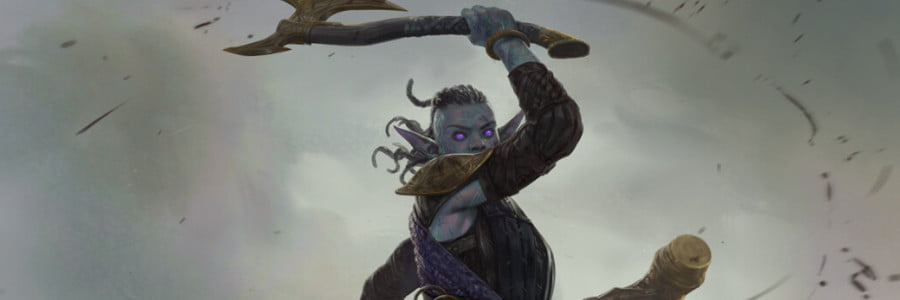
The Shadar-Kai had over time, built up a population; they had had children, they had raised their own, they had taken charge of their facilities, and they had built a connection to the Shadowfell, even making allies of the few drifting things that existed within the Shadowfell.
The Shadar-Kai are the gothic, horrifying image of the Elf; tainted by a relationship to life and death. They favour working at night, they adorn themselves with lines of gold and silver, and they all were born in a place where just over the wall is a howling desert with rolling clouds of actual death. Shadar is basically a prison repurposed as a city, with an industrial forge for Shadowsteel and other alchemical compounds and waste that the Eladrin didn’t want in their space.
There’s a strong culture of the revolutionary to the Shadar-Kai: Even if they live elsewhere coming to the Prime Material Plane, almost any given Shadar-Kai was born in Shadar or at least visited it after being born. There’s a strong cultural experience of this one hostile environment and of being there because someone else wanted you there, even if you were born there.
The big political view of the Shadar-Kai is what are they going to do about the Eladrin hovers in the air — some Shadar-Kai call for a war for dignity, a war of vengeance, and some believe it’s much better to be free and to ignore the Eladrin entirely. It’s a majority opinion that they don’t want to deal with it thanks but, y’know, it’s a very easy thing to have opinions on. This also happened a long time ago, right? Like, the Eladrin think ‘any day now, the Shadar-Kai are going to bring some stuff up,’ but it’s been like, centuries since it happened.
Oh and since Ettin’s going to say it if he ever reads this, Elfstralia.
Wrapup
Another thing to throw in here is that in every one of these heritages, people have a range of physical phenotypes that we would see when presented with humans, and in some cases it’s even more wild; rather than being a direct inheritance of genetics, the Eladrin line’s skin colours are much more of a dice rolled at birth, and then set. It’s not that ‘dark skinned elves are Drow’ and nobody in Cobrin’Seil would assume that. If your elf has bright purple patterns on their skin, or poison arrow frog eyes, then yeah, okay, they’re a drow and people would assume; similar to seeing an Eladrin with metallic shapes in their skin, that’s probably a Shadar-Kai.
Hopefully this is an example of how I think through the challenges of working with heritages that give people interesting story positions, cultures to belong to, while also trying to avoid the more classic racist cultural trope space. These are character backgrounds that give you, the player a cultural background that you can reflect without needing to replicate. Every one of these cultures has major culture-wide experiences that you can use to anchor your story to other characters, but none of them are there to tell you how you must be.
1 Trackback